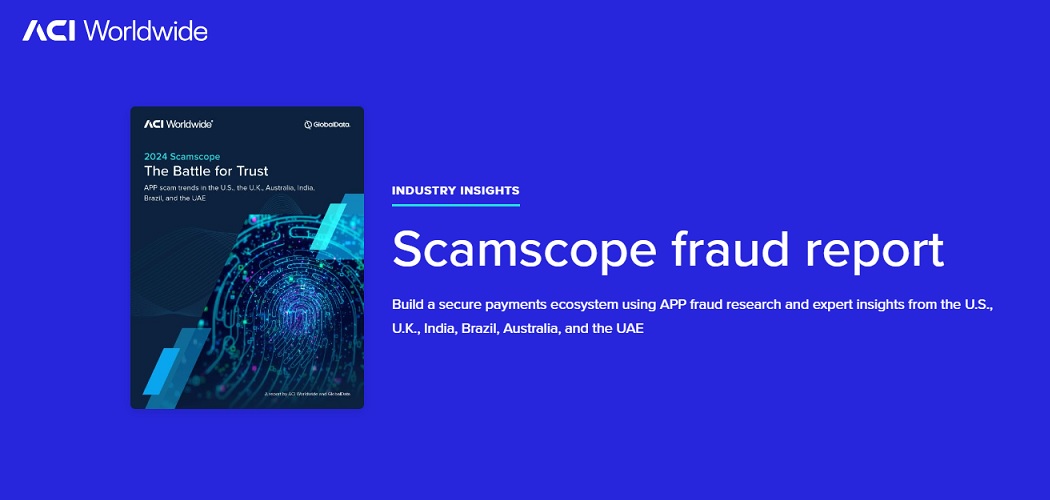
Financial institutions face significant erosion of trust and rising customer attrition as consumers fall victim to authorized push payment (APP) scams. The 2024 Scamscope report reveals that 25% of scam victims will leave their current financial institution, and around 20% close their accounts without opening new ones, underscoring the critical need for FIs to protect customers and maintain trust.
The Scamscope report projects that APP scam losses through real-time payments will see a combined 2023-2028 compound annual growth rate (CAGR) of 17% vs. 12% CAGR for total APP scam losses worldwide over the same period and will comprise 80% of total APP scam values by 2028.
Authorized push payment (APP) scam losses are on the rise, expected to climb to $7.6 billion by 2028 across six leading real-time payment markets (U.S., U.K., India, Brazil, Australia and UAE), according to the latest Scamscope report from ACI Worldwide, an original innovator in global payments technology, in partnership with GlobalData, a leading data and analytics company.
APP scammers prey on trust by deceiving individuals into willingly transferring funds to them. This trust-based manipulation makes APP scams particularly challenging to detect as the transaction appears legitimate and bypasses traditional fraud detection systems and controls. As rapid global adoption of real-time payments transforms the speed and velocity of how money moves, enabling faster and more accessible transactions, scammers are exploiting the immediacy of these transactions to steal funds before they can be traced, spurring growth in real-time payment APP scams.
„Integrating AI in financial services is a double-edged sword, both in enabling sophisticated financial crimes and fortifying defenses against them. Scammers are using AI to boost inherited trust to unprecedented levels, automating hits and driving more effective social engineering techniques,” said Cleber Martins, head of payments intelligence and risk solutions at ACI Worldwide. „The rise of real-time payment APP scams requires a coordinated cross-industry defense to share precise and collective intelligence in real time. By breaking down silos and fostering cross-border collaboration, mule networks can be dismantled to better protect consumers.„
Key report findings
Country highlights
Australia: APP scam losses in Australia have surged dramatically over the past five years, with a 2018-2023 CAGR of 42.4%. Australia has made some progress in addressing this issue with strategic initiatives such as Scamwatch and improved collaboration among industry stakeholders, leading to a projected growth slowdown over the next five years, with a 2023-2028 CAGR of 7.6%.
Brazil: As the second-largest real-time payments market globally, Brazil is projected to experience the highest growth in APP scam losses compared to other analyzed markets. APP scam losses in Brazil hit almost $380 million in 2023 and are projected to increase by almost 40% by 2028. According to Brazil’s banking association, nearly one in three Brazilians have been victims of financial scams.
India: As the biggest and most developed real-time payments market worldwide, India has seen a huge spike in APP and real-time payment scam losses in the last five years. However, APP scam losses are forecast to be the lowest in India compared to other analyzed markets, with a 2023-2028 CAGR of 5.9%. India is beginning to address scams more effectively than any other market in the study.
UAE: Despite having the lowest APP scam losses ($8.3 million) among analyzed markets in 2023,the UAE is witnessing a rise in sophisticated scams, particularly investment and SMS-based card fraud. Real-time payment APP scam losses are expected to hit $26.8 million by 2028 (2023-2028 CAGR of 30%) as real-time payments pick up momentum in the UAE.
U.K.: The U.K. is the only country in this year’s report with a year-over-year (YoY) decrease in APP fraud loss values from 2022-23 (5%).Although there has been a notable increase in APP fraud cases, there has been a slight decrease in overall financial losses, indicating more effective fraud prevention measures and lower losses per case. The new regulation that holds recipient banks jointly accountable for compensating APP scam victims could help this trend continue.
U.S.: In 2023, the U.S. saw more than $2 billion in APP scam losses. The U.S. is also a hotspot for card fraud, with more than $13 billion in losses last year. As real-time payments adoption accelerates in the U.S., APP scams will threaten consumers and financial institutions significantly, with real-time payment APP scams projected 2023-2028 CAGR at 19%, far outpacing the total APP scam 2023-2028 CAGR of 7.4%.
Country data at a glance
_____________
Authorized push payment (APP) scams: The term describes a method of fraud in which criminals coerce legitimate users to initiate a payment to a destination account under their control. Funds leaving legitimate customers’ accounts will travel through one or several mule accounts before being collected by the fraudsters or converted by them into hard-to-trace digital assets, such as crypto or NFTs.
Other terms for APP scams include „PIX fraud” in Brazil, „scams” in Australia and „APP fraud” in the U.K. This report uses the terms „APP scam” and „scams” interchangeably to refer to the same problem.
Mule networks are a collection of linked accounts belonging to individuals or businesses that are used to move the proceeds of crime.
Banking 4.0 – „how was the experience for you”
„To be honest I think that Sinaia, your conference, is much better then Davos.”
Many more interesting quotes in the video below: